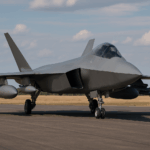PARIS — MBDA, Europe’s largest missile maker, has shown a new low‑cost drone called the One‑Way Effector (OWE). The idea is simple: send many cheap drones first, force the enemy to shoot them down, then fire expensive cruise missiles through the gaps. Company engineers began work only six months ago, a pace that matches the urgent need for mass seen during two years of drone‑heavy fighting in Ukraine. This approach reflects the intense drone‑heavy fighting experience that shaped recent military needs.
According to industry sources, the OWE is about numbers, not precision. Each drone costs far less than a cruise missile. A single set of OWEs is cheaper than one Mistral interceptor. Defense officials confirm that this flips the cost balance. This shift in the cost balance echoes recent U.S. Army efforts to strengthen mid-tier air defense with cost-effective solutions. Defenders must pick between firing a pricey interceptor or letting a 40‑kilogram warhead hit a radar site. Our analysis shows that, in modern air defense, economics matter as much as radar coverage.
One-Way Drone Concept by MBDA Emphasizes Mass Attrition Strategy and High-Volume Production
The OWE slots between loitering munitions and long‑range cruise missiles. It flies fast enough to threaten fixed batteries yet is cheap enough to buy by the thousand. Designers made it easy to detect on purpose. They want radars to light up, track, and engage the drones. This drains interceptor stocks, reveals firing positions, and disrupts command links before the high‑value missiles arrive.
Key performance data
• Range — 500 km
• Warhead — 40 kg class
• Cruise speed — 400 km/h
• Wingspan — about 3 m
• Planned output — 1,000 units per month
• Launch options — truck‑mounted ramp or container rail
Production is the heart of the plan. MBDA has teamed with a French carmaker whose name remains undisclosed. It is neither Renault nor Stellantis. The partner brings just‑in‑time logistics and high‑cycle tooling to a defense sector used to small batches. Hugo Coqueret, MBDA’s battlefield business lead, says missile firms must adopt automotive speed to deliver “mass at the tempo war demands.”
The requirement stems from battlefield evidence. Defense officials confirm that Ukraine sees drone raids in the hundreds almost every night. Crews on both sides fire expensive surface‑to‑air rounds at targets built for a few thousand euros. European armies, especially French artillery units, asked MBDA for a faster, longer‑range version of that idea. The company launched the project in December 2024 with its own funds and now seeks a French contract.
MBDA One-Way Drone Launch Tactics Mimic Artillery Salvo Methods
OWEs launch in groups, not one at a time. Twelve to twenty drones leave their rails within seconds, line up into a loose pack, and head toward preset coordinates. There is no in‑flight data link; simpler systems keep the unit inexpensive and resist hacking. Planners compare the process to artillery fire: set a grid, time a salvo, and let the rounds go. Defense officials confirm that this reduces operator workload and speeds up the kill chain. Similarly, the U.S. Army’s recent Stryker-mounted DE M-SHORAD laser live tests also aim to simplify operations and speed up the kill chain.
Pairing OWEs with weapons like Scalp or Taurus is the main sales pitch. A mixed strike—cheap first, costly second—raises the chance that expensive missiles survive. Enemy radars turn on to fight the drone cloud. Electronic‑support aircraft record those emissions. Cruise missiles then steer through the newly opened path or home on the exposed radar.
Design choices favor availability over elegance. The airframe uses commercial aluminum instead of exotic composites. Sub‑assemblies come straight from car‑industry suppliers. Engineers selected a catalog turbojet and tweaked it for better throttle response. Guidance is a hardened GPS blended with inertial cues. There is no complex seeker in the nose, which keeps the price in the “attritable” band. Part counts stay low so robots on the factory floor can swap tools quickly.
MBDA’s timeline is ambitious. The first flight is set for early autumn 2025 at a range in southwest France. If tests go well, small runs start in 2026, with the first operational lot in 2027. Coqueret calls the schedule “tight but mandatory.” French Joint Forces Command wants mass‑effect tools before 2030. Defense officials confirm that draft 2026‑2030 budgets now include funds for attritable drones. Similar accelerated production timelines appear as a priority for the U.S. Army’s mid-tier air defense programs.
France will be the launch customer, but allies are watching. According to industry sources, several NATO air staffs have requested data packs. Interest is high in countries that rely on layered air defense. They see the drone both as a threat and as a tool to thin enemy stocks early in combat. Export versions will omit French classified data links but keep the core flight control. Price will depend on volume, but MBDA hints it will sit closer to loitering munition costs than to cruise missiles.
The OWE also joins MBDA’s broader “new effectors” family, which includes AKERON‑RCX roving munitions and land‑cruise concepts. A staircase of capability is forming: cheap single‑use drones at the bottom, medium‑cost land‑attack rounds in the middle, and high‑end standoff missiles at the top. Commanders can pick the right tool without wasting premium assets on soft targets.
Success could reshape production habits. The car‑plant partnership will show whether European defense firms can jump from artisan rates to consumer‑grade throughput. If it works, other programs—counter‑UAV rockets, smart loitering rounds, maybe even air‑to‑air missiles—might follow. Defense officials confirm that ministries across Europe now demand proof that suppliers can surge output in crisis, not just during peacetime press events.
Technical and Operational Challenges for MBDA’s One-Way Drone Deployment
Electronics must resist jamming without spiking cost. Launch crews need clear rules for firing large drone packs in crowded skies. Armies must train operators who know missile tactics yet think in artillery volumes. None of these hurdles is small, but the mix of Ukraine’s lessons and Indo‑Pacific tension pushes governments to solve them fast.
The coming flight test will show whether theory matches practice. A swarm of expendable aircraft will try to drain an air‑defense battery, open a corridor, and let cruise missiles break through. If it works, Europe’s missile force gains room to breathe, and defenders face a punishing math problem. If it fails, MBDA still gains a high‑rate production model that can shift to other tasks, from radar decoys to electronic‑warfare payloads.Defense‑Aerospace editorial team will follow the tests and tell readers whether low‑cost mass becomes combat‑credible power.
REFERENCE SOURCES
- https://defence-industry.eu/mbda-reveals-one-way-effector-new-mass-production-saturation-weapon-at-paris-air-show-2025/
- https://www.defensenews.com/global/europe/2025/06/17/mbda-offers-cheap-drone-swarm-as-door-opener-for-its-pricey-missiles/
- https://www.shephardmedia.com/news/landwarfareintl/paris-air-show-2025-mbda-bets-on-automotive-company-to-help-mass-produce-new-one-way-effector/
- https://breakingdefense.com/2025/06/mbda-unveils-one-way-drone-eyeing-1000-unit-a-month-production-rate/
- https://www.naval-technology.com/news/paris-air-show-2025-mbda-mass-effector-meets-french-artillery-requirement/
- httsp://aviationweek.com/defense/aircraft-propulsion/mbda-targets-french-need-long-range-one-way-attack-drone/


